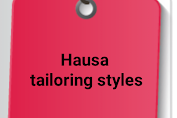Hausa tailoring styles are a significant part of the fashion industry in West Africa, particularly in Nigeria.
These styles are known for their bold, vibrant colors and intricate patterns, which reflect the cultural heritage and creativity of the Hausa people.
The origins of Hausa tailoring can be traced back to the pre-colonial era, when the Hausa people were known for their expertise in textiles and clothing production. Hausa tailors were skilled craftsmen who used traditional techniques to create elaborate garments for both everyday wear and special occasions.
One of the most distinctive features of Hausa tailoring is the use of rich, vibrant colors. Hausa tailors have a reputation for incorporating a wide range of colors into their designs, including bright shades of red, yellow, and green. This is a reflection of the Hausa people’s love of color and their belief that it brings joy and happiness.
In addition to their use of color, Hausa tailors are also known for their intricate patterns and designs. These patterns are often inspired by nature, with motifs of plants, animals, and other natural elements being incorporated into the fabric. The use of these patterns is a way of celebrating the beauty of the natural world and paying tribute to the cultural traditions of the Hausa people.
Hausa tailoring styles are not just limited to traditional clothing, however. Over the years, Hausa tailors have adapted their skills to create a range of modern garments, including suits, dresses, and casual wear. This has allowed them to stay relevant in a rapidly changing fashion industry, while still maintaining their cultural roots.
One of the most popular types of Hausa tailoring is known as the “buba” style. This is a traditional men’s garment that consists of a long, loose-fitting shirt with wide sleeves and a high collar. It is often worn with a pair of trousers or a wrap-around skirt known as a “sarong.” The buba style is characterized by its use of bright colors and intricate patterns, and it is a staple of Hausa fashion.
Another popular Hausa tailoring style is the “fustan” or “gwanjo” style, which is a traditional women’s garment. The fustan is a long, flowing dress that is worn with a headwrap and a pair of slippers. It is often adorned with intricate embroidery and beadwork, and it is a popular choice for formal occasions such as weddings and other celebrations.
In addition to these traditional styles, Hausa tailors have also embraced modern fashion trends, creating a range of garments that are suitable for everyday wear. This includes everything from casual t-shirts and jeans to formal business attire. Hausa tailors have a reputation for being able to adapt to changing fashion trends, while still maintaining their cultural identity.
Hausa tailoring is not just about creating beautiful garments, however. It is also a way for the Hausa people to preserve their cultural heritage and pass it down to future generations. Hausa tailors often work within their communities, teaching young people the traditional techniques and skills that are needed to create these intricate garments. This helps to ensure that the Hausa tailoring tradition will continue to thrive and evolve in the future.
Hausa tailoring styles are an integral part of the fashion industry in West Africa, and they are known for their bold, vibrant colors and intricate patterns. These styles are a reflection of the Hausa people’s cultural heritage and creativity, and they are a way for them to preserve their traditions and pass them down to future generations. Hausa tail
tailors have adapted their skills to create a range of modern garments, while still maintaining their cultural roots, and their work is not only about creating beautiful clothing, but also about preserving their cultural traditions.
Hausa tailoring is a vital part of the economy in Nigeria and other West African countries, and it has a strong presence in the global fashion industry. Hausa tailors have been able to build a reputation for their high-quality, unique garments, and they have gained a loyal customer base both locally and internationally.
Despite the success of Hausa tailoring, it is not without its challenges. One of the main challenges facing Hausa tailors is the lack of access to modern equipment and technology. Many Hausa tailors still rely on traditional techniques and tools, which can be time-consuming and labor-intensive. This can make it difficult for them to keep up with the demand for their garments, especially as the fashion industry becomes more fast-paced and competitive.
Another challenge facing Hausa tailoring is the lack of support and recognition from the government. Many Hausa tailors struggle to get the financial and legal support they need to grow their businesses and reach new markets. This can make it difficult for them to sustain their livelihoods and contribute to the economy.
Despite these challenges, Hausa tailoring continues to thrive and evolve, and it remains a vital part of the cultural and economic fabric of West Africa. With the support of the government and the wider community, Hausa tailors can continue to preserve their cultural traditions and share them with the world.



























Post a Comment